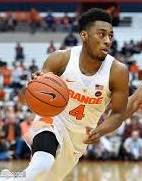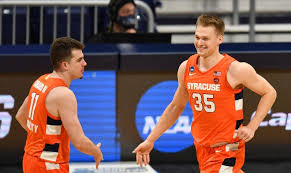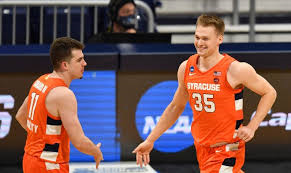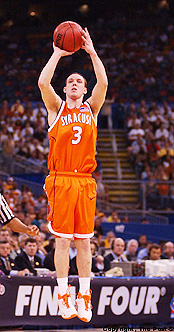Sunday, March 05, 2023
Syracuse Senior Day - Big Senior Games
Monday, March 28, 2022
Syracuse 2021-22 Free Throw Shooting
Sunday, January 16, 2022
Orange Backcourt Free Throw Shooting - Who's the Best?
Free throw shooting has long been the Achille's Heel of Syracuse basketball. A lot of fans may not have been paying attention, however, and noticed that the Orange have gotten much better as a team in that area the past few years. In fact last year's team was the best free throw shooting team in Syracuse history, and their clip of 78.2% is significantly better than the previous record of 75.1% set in the 1983-1984 season. The 2019-2020 season is now the fourth best on record for the Orange, so definitely an upward trend.
It is vital for a team to have a solid free throw shooting backcourt, as it helps to ice the lead late in a game. Buddy Boeheim and Joe Girard are currently shooting at a combined 89.7%, hitting 105 of 117 attempts through the first 17 games. This would break the Orange record for free throw percentage for the starting backcourt. Boeheim is shooting 90.4% while Girard is hitting 88.6%, truly a team effort for the duo.There are thirteen Orange starting backcourts that have made 78% or more of their free throws. Here are the thirteen, in order, with the current record holder listed first.
1. 2005-2006. Gerry McNamara hit 90.2% of his shots and Eric Devendorf 81.1%, as the duo combined for 175-201 for 87.1%. GMac is the school's all-time career free throw shooter, and Devo is 15th, so this really should not be a surprise for anyone.
2. 2016-2017. John Gillon hit 86.1% and Tyus Battle 79.8% as the duo combined for 84.8% on 190-224.
3. 2020-2021. Joe Girard hit 78% and Buddy Boeheim 84.9%, for a combined 84-103 for 81.6%. So it should not be a surprise that the duo is taking a run at the record. This is the least prolific duo on this list, even if you prorate the number of free throws to account for games missed due to Covid-19.
4. 2019-2020. Joe Girard hit 89.4% and Buddy Boeheim 71.4% for a combined 122-150 for 81.3%. This is a reverse of the following year, with Girard carrying load over Boeheim.
5. 1971-1972. Dennis DuVal hit only 66.0% and Greg Kohls 86.4%, for a combined 290-360 for 80.6%. This was a case of Kohls taking the vast majority of the free throw attempts. This was by far the most prolific free throw shooting duo of the top 13. Kohls took 257 of the free throw attempts himself, an outstanding number.
6. 1978-1979. Hal Cohen hit 76.9% and Marty Headd 82.1%, for a combined 105-132 for 79.5%.
7. 1967-1968. Rich Cornwall hit 85.9% and Ernie Austin 69.6% for a combined 112-141 for 79.4%.
8. 1984-1985. Pearl Washington hit 78.4% and Michael Brown 87.0%, for a combined 158-199 for 79.4%. In retrospect I wonder how many fans realized that the Pearl was a solid free throw shooter?
9. 2017-2018. Frank Howard hit 71.9% and Tyus Battle 83.9% for a combined 259-327 for 79.2%.
10. 2008-2009. Jonny Flynn hit 78.6% and Eric Devendorf 79.5% for a combined 277-351 for 78.9% This is the second most prolific duo on this list.
11. 2013-2014. Tyler Ennis hit 76.5% and Trevor Cooney 84.1% for a combined 167-212 for 78.8%.
12. 2004-2005 Gerry McNamara hit 87.4% and Louis McCroskey a very poor 50%, for a combined 131-167 for 78.4%. This was clearly a case of GMac carrying all the load of free throws.
13. 2002-2003. Gerry McNamara hit 90.9% and Kueth Duany a weak 67.5% for a combined 167-213 for 78.4%. Again, GMac carried the load for the free throws, but the duo did help lead the Orange to a National Championship. This is GMac's third entry on this list.
Boeheim and Girard will almost certainly make an entry into this top list, and have a real shot at #1. They already hold the third and fourth positions.
While doing this research, I found it interesting that most of the top free throw shooting backcourts for the Orange were in the past twenty years, with nine out of thirteen. The worst free throw shooting backcourts were predominantly in the 1950s and early 1960s. So when your father/grandfather says that "young players today don't know the fundamentals such as free throw shooting like we knew when I was growing up", you now have the evidence to contradict him.
Wednesday, September 29, 2021
OrangeHoops Hall of Fame 2021
In 2007, OrangeHoops inducted its charter class into the OrangeHoops Hall of Fame: Dave Bing, Derrick Coleman, Sherman Douglas, Vic Hanson, and Pearl Washington. The next ten years saw the addition of Billy Owens (2008), Billy Gabor (2009), Lawrence Moten (2010), Louis Orr (2011), Roosevelt Bouie (2011) John Wallace (2012), Rony Seikaly (2013), Vinnie Cohen (2014), Etan Thomas (2015), Joe Schwarzer (2016), Lew Andreas (2017), Carmelo Anthony (2018), Stephen Thompson (2019), and Hakim Warrick (2020). So the list now stands at 19. Another year has passed, and now it is time for the 2021 inductee.
DuVal was a flashy point guard for Syracuse in the early 70s. When he graduated from Syracuse he was only second to Dave Bing in career points scored. He was a three year started and averaged 18.6 ppg. DuVal was a third team All-American his senior year
Saturday, March 04, 2017
40 for Two Orangemen
 |
| Andrew White III and John Gillon |
It's an eclectic mix of collegiate talent on the above list. Bing was an All American, and became a Hall of Fame NBA player. Bill Smith, Ed Miller and Frank Reddout had short NBA careers. Gerry McNamara was a legendary collegiate player, who had a short professional career before turning to coaching. Chudy was the leading scorer on the Orangemen his junior and senior seasons, and had several games with thirty-plus points. Waldron was a low scoring guard for the Orangemen in the mid 80s, and was a three year starter.
Saturday, February 04, 2017
Gillon’s 43 points: One for the Ages
 |
| John Gillon III |
Saturday, May 07, 2016
Jim Boeheim: Quick Comments on YESNetwork
I think we all knew Boeheim really liked and respected Gerry McNamara, but I don't think I really knew how much. The first video clip, particularly his last comments, really points it out. Boeheim states that GMac is the toughest player he ever coached, the biggest overachiever, and the guy he would want in a foxhole with him.
I think most Syracuse fans have heard the Jim Boeheim story about hiring Rick Pitino. I don't think I ever realized before that Boeheim didn't know Pitino at the time.
I always had a very high opinion of Chris Mullin as a player. Apparently, Boeheim does too.
Monday, August 03, 2015
The 1986-1987 Orangemen versus the 2002-2003 Orangemen
Sunday, December 14, 2014
A Flash of GMac
Saturday, November 15, 2014
2014-2015 Season of Questions
Thursday, March 13, 2014
Winning the Conference Tournament
Wednesday, October 16, 2013
Freshmen at the Point
Friday, March 05, 2010
Syracuse Basketball Videos
Wednesday, April 15, 2009
Syracuse All Decade Team 2000-2009
Flynn leaves Syracuse as probably the third best point guard in the Jim Boeheim era. The top two are clearly Pearl Washington and Sherman Douglas, in some order. Flynn comes in ahead of guys like Red Autry, Gerry McNamara, Jason Hart , Lazarus Sims and Eddie Moss.
Anyways, the decade from 2000-2009 has ended, and I have been compiling ‘All Decade’ Teams for every decade of Syracuse basketball, along with a player of the decade for each decade. [Note: for purposes of determining best player of a decade, I restrict consideration to only their activity during that decade. I realize this is unfair to the players who cross over two decades, but such as it is].
Most decades have been easy. The 1900s had Art Powell, the 1910s Joe Schwarzer, the 1920s Vic Hanson, the 1930s Ed Sonderman, the 1940s Billy Gabor, the 1950s Vinnie Cohen, and the 1960s Dave Bing.
The choices got more difficult starting with the 1970s. I narrowed it down to Rudy Hackett, Roosevelt Bouie, Louis Orr, and Dennis DuVal. DuVal was an electrifying and outstanding player, and Hackett led Syracuse to its first Final Four, but both of their impact was dwarfed by the dominance of the Bouie ‘N Louie era. So the choice came down to Louis Orr and Roosevelt Bouie. Considering the defensive dominance of Bouie that allowed a young Jim Boeheim to anchor a team around, I had to go with Roosevelt Bouie for the 1970s.
The 1980s was the best decade of Syracuse basketball, and as such there were some dominant players to select from. The top three were clearly Pearl Washington, Derrick Coleman and Sherman Douglas. Coleman was the best player of the three, but his senior season was in the 1990s, and so we’re comparing his first three seasons to the three years of Washington and four of Douglas. I think the point guard duo have an edge as a result. It then comes down to Washington and Douglas. I think Douglas was the better point guard, and the guy I want running my team. But the Pearl was an outstanding point guard himself, and a one-man press breaking machine. Honestly, I would not argue with anyone who chose opposite to me on this, but in the end I took the Pearl because of his impact on the program.
The 1990s had three outstanding players: Billy Owens, Lawrence Moten and John Wallace. Owens was the best player of the three, but Syracuse had only two seasons of him in the 1990s, and Owens has to be downgraded somewhat for his failure to win a Big East game or NCAA tournament game his last season at Syracuse. I mean, that’s half the seasons he had in the 1990s. Moten and Wallace were both four year men. Moten was the better four year player; he was a much better player than Wallace was as a freshman and sophomore. And I had written a while back that Moten’s significance in the 90s cannot be understated… he came to the program at the time of the probation period, and helped Syracuse be a winner despite the NCAA penalties, and the program kept going as a result. Moten is one of my all time favorite Syracuse players, but I gave John Wallace the nod as the top player of the 90s. He was a better player as a junior and senior than Moten was those two years, and Wallace carried the team to the NCAA Championship game his senior season.
As tough as I found the last three decades to be for selections, I found this past decade (2000-2009) to be the toughest. One of the difficulties is the presence of Carmelo Anthony, who played only one year, but clearly had the best single season of the decade and led Syracuse to its first NCAA Tournament Championship. Then you have Hak & Mac attack with Hakim Warrick and Gerry McNamara, and the ironman Jonny Flynn.
First, I will be quite clear that I have a tough time naming any player the greatest career player, or player of a decade, when his contribution to the school was only one season. That pretty much makes it very difficult for me to select Anthony. Yes, Anthony had the best single season, and he did win a National Championship. But Hakim Warrick and Gerry McNamara both also won a National Championship, in which both were significant impact players (remember ‘the block’ and ‘six threes’?).
Consider that Warrick scored over 2000 points during the decade, was the team’s leading rebounder for the decade, played in three NCAA tournaments, won a Big East Championship his senior season, and was named the Big East Player of the Year his Senior year, and all Big East first team two times.
Gerry McNamara led the school in scoring and assists for the decade, played in four NCAA tournaments (the only Orangeman to do that in the 2000s), won two Big East tournaments (including perhaps the gutsiest four series effort by a player in the history of that tournament). GMac was of course a fan favorite.
And recently we have all had the pleasure of watching Jonny Flynn and his ironman efforts on the court, and his own heroic Big East tournament efforts this season.
Gerry McNamara came away with the most hardware for the decade, but the other three were better players. Flynn was fun to watch the last two years, but Warrick and Anthony were better. So it comes down to Anthony and Warrick. Warrick was Anthony’s wingman in 2003. But as I mentioned earlier, Anthony only played one year, and he won a National Title (but so did Warrick). Anthony never won a Big East title, and he was never the Big East Player of the Year (I know that politics played into that, but nevertheless it is a fact). If Warrick had played two years and Anthony one, I could go with Anthony. But Warrick played four years; Anthony only one. Warrick had impact on 40% of the decade, Anthony only 10%. Warrick played in 3 NCAA tournaments, Anthony one. Warrick won a Big East Title, Anthony none. Warrick was on the Big East First team 2x, Anthony only once. Warrick was the Big East Player of the Year, Anthony never won that distinction.
We could play the ‘yeah, but’ game with Anthony. If Anthony had stayed four years, he likely would’ve bettered all of Warrick’s accomplishments. But Anthony made a choice to leave Syracuse and go pro; Warrick chose to stay four years. I am not going to make a decision based on what could have happened, but instead on what actually did happen. And based on that, I choose Mr. Warrick.
As for the All Decade team, that a bit easier. I came down to a backcourt of Jonny Flynn and Gerry McNamara, and a front court of Carmelo Anthony, Hakim Warrick and Arinze Onuaku. I would have a three man bench, and this bench would help the Orange shoot the lights out: Preston Shumpert, Eric Devendorf, and Demetris Nichols. Of course, the coach of the decade would be the only coach this decade, Jim Boehim.
Agree or disagree with the Player of the Decade decision? I’ve set up a ranking on Rankopedia for you to make your own vote. And if you want to comment on any of the previous decade selections, feel free to leave me a comment.
It’s a long time until next fall, but I’ll be here every week or so with more comments on the Orange of past and present.








